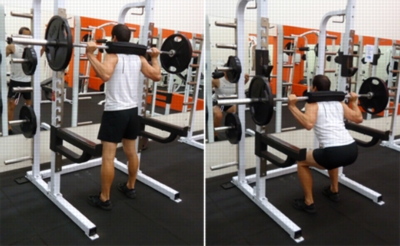Strengthening (Muscles)
Updated:

View progressive strengthening exercises designed by our experienced Physiotherapists for major muscles of the body:
AbdominalsThe following abdominal strengthening exercises are designed to improve the strength of the abdominal muscles (figure 1). You should discuss the suitability of these abdominal strengthening exercises with your physiotherapist prior to beginning them. Generally, they should only be performed provided they do not cause or increase pain. Begin with the basic abdominal strengthening exercises. Once…BicepsThe following bicep strengthening exercises are designed to improve the strength of the biceps muscles (figure 1). You should discuss the suitability of these bicep exercises with your physiotherapist prior to beginning them. Generally, they should only be performed provided they do not cause or increase pain. Begin with the Basic Bicep Strengthening Exercise. Once…CalfThe following calf strengthening exercises are designed to improve strength of the calf muscles (figure 1). You should discuss the suitability of these calf exercises with your physiotherapist prior to beginning them. Generally, they should only be performed provided they do not cause or increase pain. Begin with the basic calf strengthening exercise. Once this…Deltoid (Shoulders)The following deltoid strengthening exercises are designed to improve the strength of the deltoid muscles (figure 1). You should discuss the suitability of these deltoid exercises with your physiotherapist prior to beginning them. Generally, they should only be performed provided they do not cause or increase pain. Begin with the basic deltoid strengthening exercise. Once…GlutealsThe following gluteal strengthening exercises are designed to improve the strength of the gluteal (bottom) muscles (figure 1). You should discuss the suitability of these gluteal strengthening exercises with your physiotherapist prior to beginning them. Generally, they should only be performed provided they do not cause or increase pain. Begin with the basic gluteal strengthening…Groin (Adductors)The following groin strengthening exercises are designed to improve strength of the groin (adductor) muscles (figure 1). You should discuss the suitability of these exercises with your physiotherapist prior to beginning them. Generally, they should only be performed provided they do not cause or increase pain. Begin with the basic groin strengthening exercises. Once these…HamstringsThe following hamstring strengthening exercises are designed to improve the strength of the hamstring muscles (figure 1). You should discuss the suitability of these hamstring exercises with your physiotherapist prior to beginning them. Generally, they should only be performed provided they do not cause or increase pain. Begin with the basic hamstring strengthening exercise. Once…Hip Flexors (Psoas)The following hip flexor strengthening exercises are designed to improve strength of the hip flexor muscles (Iliopsoas). You should discuss the suitability of these exercises with your physiotherapist prior to beginning them. Generally, they should only be performed provided they do not cause or increase pain. Begin with the basic hip flexor strengthening exercises. Once…Latissimus DorsiThe following latissimus dorsi strengthening exercises are designed to improve the strength of the latissimus dorsi muscles (figure 1). You should discuss the suitability of these exercises with your physiotherapist prior to beginning them. Generally, they should only be performed provided they do not cause or increase pain. Begin with the basic latissimus dorsi strengthening…PectoralsThe following pectoral strengthening exercises are designed to improve the strength of the pectoral muscles (figure 1). You should discuss the suitability of these pectoral exercises with your physiotherapist prior to beginning them. Generally, they should only be performed provided they do not cause or increase pain. Begin with the basic pectoral strengthening exercise. Once…Pelvic FloorThe following pelvic floor exercises are frequently prescribed in physiotherapy clinical practice to improve strength and control of the pelvic floor muscles and to prevent or treat pelvic floor dysfunction which frequently occurs in women following childbirth and gynaecological surgery, and in men following prostate surgery. In general, pelvic floor exercises are extremely important for…QuadricepsThe following quadriceps strengthening exercises are designed to improve strength of the quadriceps muscle (figure 1). The quadriceps comprises of four muscle bellies, one of which is the VMO (Vastus Medialis Obliquus). The VMO is very important in quadriceps and knee rehabilitation exercises. You should discuss the suitability of these exercises with your physiotherapist prior…Rhomboids (Mid Back)The following rhomboid strengthening exercises are designed to improve the strength of the rhomboid muscles (figure 1). You should discuss the suitability of these exercises with your physiotherapist prior to beginning them. Generally, they should only be performed provided they do not cause or increase pain. Begin with the basic rhomboid strengthening exercise. Once this…Rotator CuffThe following rotator cuff strengthening exercises are designed to improve the strength of the rotator cuff muscles (figure 1). You should discuss the suitability of these exercises with your physiotherapist prior to beginning them. Generally, they should only be performed provided they do not cause or increase pain. Begin with the basic rotator cuff…TricepsThe following triceps strengthening exercises are designed to improve strength of the triceps muscles (figure 1). You should discuss the suitability of these exercises with your physiotherapist prior to beginning them. Generally, they should only be performed provided they do not cause or increase pain. Begin with the basic triceps strengthening exercise. Once this is…
Link to this Page
If you would like to link to this article on your website, simply copy the code below and add it to your page:
<a href="https://physioadvisor.com.au/exercises/strengthening-muscles”>Strengthening (Muscles) – PhysioAdvisor.com</a><br/>
Return to the top of Strengthening (Muscles).
